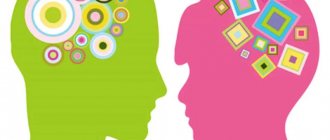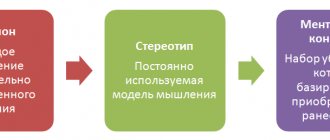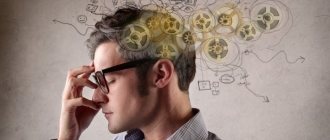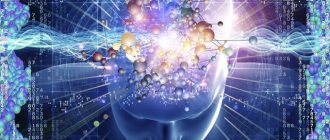Cognitive psychology views the human psyche as a kind of computer. Her area of interest is the processes of cognition, processing, storage and reproduction of information. Briefly, the essence of the direction can be reflected as follows: the study of the mind.
For example, in cognitive psychology the question is considered: how exactly does a person select data for study?
The essence and ideas of science
Cognitivism in psychology studies the cognitive processes occurring in the human psyche. This direction of psychological science should answer the following questions:
- How can an individual solve problems?
- How are thoughts formulated using language?
- How does the brain process incoming information?
- How is memory formed?
Direction ideas:
- Accounting for chronometric data. Researchers calculate the time a person spends searching for solutions to problems.
- Step by step processing. The information received is analyzed step by step, while some of it remains unconscious.
- Comparison of cognitive processes that occur in the human brain with the work of a modern computer. Researchers highlight the main similarity - an electronic device can receive, store, and process information, similar to the work of the human brain.
- Calculation of the volume of the human psyche. Researchers are confident that there is a limit to everything related to the functioning of the brain.
- The foundation of the cognitive psyche is cognitive processes. The main emphasis of the studies is on the development and understanding of artificial intelligence.
- Encoding. Scientists put forward the theory that any data has an individual code that allows the information received to be divided into separate cells.
Having studied the ideas of this science, we can conclude that this is not a new express training created to make money, but a serious scientific direction.
[edit] A little history, or how Moscow studied Moscow
To understand how the psycholunatics and pogromists came to such an innovative (she is only about sixty years old) concept, it is necessary to understand how ideas about the psyche developed before that.
In the dark ages, instead of a psyche, people had a soul, and only G‑d and the Russian Orthodox Church knew what was going on in it. Around the end of the nineteenth century, scientists were somewhat fed up with this state of affairs, and they began to think of something to replace the soul with.
On the one hand, there was Freud with his psychoanalysis, as well as his many followers. “Come on, everyone started delving into themselves!” - Freud exclaimed, and came up with the conscious, unconscious and preconscious. The point was that only the deep and rich inner world of a person is important and meaningful. And this world, bitch, is so deep and rich that even Freud himself and even Allah cannot explain how it works. Nevertheless, Freud did bring some of his patients out of depression into a normal state, and therefore psychoanalysis was recognized as workable and began to be developed.
On the other hand, there were the behaviorists. Under the impression of Pavlov’s dogs, a certain John Watson, not the same as Holmes, but also a doctor, decided that man is the same animal. This means that the behavior of pathetic humans and other rats is based on the “stimulus - erection-response” system. Like if you kicked a bear, the bear ate you. As for the soul and consciousness, they do not exist, “what cannot be measured does not exist.”
The system was excellent in terms of “scientific”, since the stimulus and reactions could be measured by objective means. And even hints in terms of psychotherapy appeared - since a person has behavior, then you just need to train him, like Kuklachev his cats, and everything will be fine with him. Having got their hands on the scientific method, psychologists began conducting experiments on people. Early experiments amaze with their naive cynicism, and cause righteous anger among those who are especially sensitive.
However, there were some problems. Firstly, the “stimulus-response” scheme did not always work in the same way. Animals, and especially humans, could have different reflexes to the same stimuli. Secondly, scientists, willy-nilly, admitted to themselves that in addition to the “S → R” scheme, there was something else in their heads. A little later, neobehaviorists
tried to get out and expanded the model of the human head with the letter V - some intermediate factors that secure the chains S → R. However, even this very V was, at best, a simple multiplier that either strengthens the connection between stimulus and response, or weakens it. Academic psychologists were afraid to put forward more complex ideas about what might be happening inside the head.
Psychotherapists also did not sit idly by; in fact, the entire subsequent history of psychotherapy up to the cognitive scientists was built on Freud’s ideas - that the rich inner world decides. Gestaltists, for example, just populated the consciousness and subconscious with images that a person somehow evaluates and wants to complete, telescientists tried to establish contact with the unconscious through kicking a mortal carcass, and Erich Fromm generally stated that a person is driven by the meanings of life, but that no one knew what to do with it.
The situation was further worsened by the fact that these two directions were in a fierce, frantic fight with each other. In scientific circles, especially American ones, behaviorism continued to rule, ignoring both Freud and the existence of mind/consciousness in general, and in psychotherapy, on the contrary, psychoanalysis and gestalttherapy ruled, and behaviorism was despised.
And then, in this hell and gnashing of teeth, hope appeared.
Models of attention
There are three models of attention. Early selection by D. Broadbent. Represents a data link limitation. Peculiarities:
- The transmission channel is the central nervous system. Has limited bandwidth.
- Selection occurs in the early stages of sensory analysis.
Processing stages:
- Physical stimuli affect the senses.
- With the help of sensory registration, incoming data is stored in iconic memory.
- Significant information is filtered out using a filter.
- The last stage is the analysis of the selected data.
Late selection by Donald Norman:
- Incoming data is simultaneously identified, processed, and undergoes initial analysis.
- Important information is filtered out.
- The selected data undergoes in-depth analysis. Unnecessary information after processing
- forgotten.
Model of A. M. Treisman:
- Between the verbal analysis of the message and the input sensory signals there is a perceptual filter. Its task is to amplify various signals and filter out unnecessary information.
- When the data passes the filter, the information is divided into separate streams with different activation thresholds.
Data is processed in different ways. There are two methods:
- Without concentration, concentration, conscious effort. Automatic processing that occurs in parallel, quickly. Once data is received by the main receptors, it is quickly processed. In this case, the most simple, noticeable signs of objects are highlighted.
- Focusing attention. Processing takes place sequentially. To do this you need to concentrate your attention and make a conscious effort.
History of the scientific direction
We can say that cognitive psychology owes its emergence to American scientists. It was they who showed serious interest in human consciousness in the forties of the last century.
Over time, this interest has generated a large number of research papers, experiments and new terms. Gradually, the concept of cognition is firmly established in psychology. It begins to act as a determinant not only of human consciousness, but also of almost all of its actions. Of course, this was not yet cognitive psychology. Neisser laid the foundation for serious research in this direction, which later began to overlap with the work of other scientists. They also placed first place a person’s knowledge about himself and the world around him, which allows him to create new behavioral patterns and acquire certain skills.
It is interesting that initially this direction was difficult to consider homogeneous. This trend has continued to this day, because cognitive psychology is not a single school. Rather, it can be described as a wide range of tasks united by a common terminology and study methodology. With their help, certain psychological phenomena are described and explained.
Advantages and disadvantages
Advantages:
- availability of experimental studies;
- the development of this direction makes a huge contribution to psychotherapy and health management;
- active study of the work of the central nervous system, thought formation, memorization.
Flaws:
- Even despite the active development of the direction, it represents a set of theories, statements, teachings, but not a separate school.
- Neglect of motivation and affect as the most important correlates. Cognitive approaches to studying personality provide favorable predictions for the future.
General characteristics of the new direction
Cognitive psychology (representatives of this direction have done a lot to popularize it and set the main tasks) currently occupies a fairly large section in psychology as a science. The very name of this movement is derived from the Latin word meaning “knowledge.” After all, it is the one most often referred to by representatives of cognitive psychology.
The conclusions that were drawn by this scientific movement later became widely used in other disciplines. First of all, of course, psychological. They are regularly addressed by social psychology, educational psychology and psycholinguistics.
The main difference between this direction and others is the consideration of the human psyche as a certain set of patterns formed in the process of understanding the world. Followers and representatives of cognitive psychology, unlike their predecessors, pay great attention to cognitive processes. After all, they provide the necessary experience and the opportunity to analyze the situation in order to make the right decision. In the future, the same algorithm of actions will be used in similar situations. However, under changing conditions, he will also change. That is, human behavior is determined not so much by the inclinations and influences of the external environment inherent in it, but by mental processes and abilities.
Cognitive psychology and its representatives (U. Neisser, for example) believe that all knowledge acquired by a person during life is transformed into certain schemes. They are stored in specific memory cells and retrieved from there when necessary. We can say that all the activity of an individual occurs within this framework. But we cannot assume that they are static. Cognitive activity occurs constantly, which means that new schemes regularly appear and old ones are updated. Representatives of cognitive psychology do not consider attention as something separate. It is studied in the totality of all cognitive processes, such as thinking, memory, perception, and so on.
Research methods
The modern direction of cognitivism represents many concepts combined with each other. Research carried out within the framework of the development of cognitive psychology pursues the following goals:
- study of perception;
- study of memory, sorting, data storage;
- studying the cognitive picture of the world;
- the study of cognition of any living organisms;
- study of attributive processes;
- study of unconscious behavior, cognition, perception.
The main method of conducting research is laboratory experiments. Methodological settings:
- cognition determines behavior;
- mental education is the main source of data;
- behavior is a holistic phenomenon.
When conducting research, scientists do not use the generally accepted model of brain function. The work takes place in narrow specialized areas - reading, memorization.
Content
- 1 A little history, or how Moscow studied Moscow
- 2 The essence of the method 2.1 What is “cognitive”?
- 3.1 Experimental confirmation
- 4.1 Maslow's pyramid
Interaction with other sciences
The basic principles of cognitive psychology are used to develop various branches of psychological science:
- social psychology;
- personal development;
- educational psychology.
The teachings of cognitivism contradict neuroscience. Neurobiological studies (such as MRI) show brain function without providing information about mental processes. The empirical approach followed by followers of cognitive psychology is rejected by neuroscience. They argue that cognitive scientists are busy creating models of artificial intelligence. At the same time, cognitive scientists themselves have a positive attitude towards the research conducted by neuroscientists. The data obtained is used to create your own theories.
Cognitive psychology is not just another pseudoscientific branch of psychological science that was developed to make money. It is a serious science of a new generation that studies the acquisition, distribution and storage of information in memory.
Structure of cognitive psychology
Cognitive psychology at the current stage of development includes theories and practical methods from 10 main areas of research, which include:
- perception;
- pattern recognition;
- attention;
- memory;
- imagination;
- language functions;
- developmental psychology;
- thinking;
- human intelligence;
- artificial intelligence.
The research examines perception, attention, memory, knowledge, language, artificial intelligence, which are described as processes of collecting information, storing and organizing it, and as the logical conclusion of the process of using the information received.
For a clearer understanding of the features of the information collection mechanism, it is necessary to understand the features of the system for interpreting sensory signals and be able to recognize formed patterns of behavior. The process of recognizing formed patterns is essentially a comparison of stimuli with the information that is in the long-term storage of human memory. Thanks to this ability, a person is able to identify the information received, analyze it in his mind and draw appropriate conclusions.
Impact on mental health
In addition to understanding how the human mind works, the field of cognitive psychology has also influenced attitudes toward mental health. Until the 1970s, many directions in the study of the psyche focused on analytical, behavioral, and humanistic approaches.
The so-called cognitive revolution that occurred during this period placed greater emphasis on understanding how people process information.
It turns out that thinking patterns can contribute to psychological breakdown. Through research in this area, psychologists have developed new approaches to treating depression, anxiety, phobias and other disorders.
Cognitive behavioral therapy and rational emotive therapy are two methods in which clients and therapists focus on the underlying processes that lead to the disorder. Using these techniques, specialists help patients identify irrational beliefs and other distortions that conflict with reality, and then replace them with healthier thoughts.
If a person is experiencing symptoms of a psychological disorder that can be addressed by using cognitive approaches, they may want to see a psychologist trained in this setting. These specialists are psychiatrists and psychotherapists. They use strategies based on CP in their work.
Types of cognitive processes
Low or basic
Sensation and perception
Determination - what is it in psychology
A sensation is something that is formed under the action of various stimuli, as well as the determination of signals from a person’s environment. He accepts them with the help of his feelings. This is how information is acquired from the environment around you. Data comes from the outside world, and sometimes from the human body. The process of perceiving a basic type includes some interpretation of the information received.
Attention! There is plenty of information around, yet each person has the ability, having received many different signal stimuli, to pay attention to what is really interesting to her. Some actions do not require attention. This is, for example, moving or chewing food. Others require attention without fail, such as speech or body language.
Some processes that are repeated often in life are done automatically. When learning to drive a car, it is difficult to immediately act in a coordinated manner, but then less and less effort is put in, as automaticity develops.
About memory
Human memory stores answers to a fairly large number of different questions. It encrypts data, it is able to save it, and then restore it if necessary. The classification of types of memory is as follows:
- Memory is short or short-term;
- Sensory type memory;
- Semantic type memory;
- Working memory;
- Autobiographical memory and others.
All of these species are capable of interacting or not. For example, if a person with amnesia remembers where he needs to go today, he may forget the name of his closest relative.
Attention and memory
Processes are complex and higher
Intelligence or mind
This concept means an ability that gives an individual the ability to solve a variety of problems. Some scientists have popularized in society the theory that there is no intelligence, but only different abilities that are used according to the situation or activity.
On a note. In order to skillfully deal with different circumstances in everyday life, many researchers emphasize the importance of emotional intelligence.
Thinking
Human thoughts are complex and heterogeneous. This process is necessary in order to make decisions, reason, solve problems, and think creatively.
In order to make these functions somewhat simpler, the human brain creates judgments and inferences. In order for mental processes to speed up, it is necessary to group events, people, objects, and so on.
Often people use shortcuts to make the thought process happen faster, and do not process information in general. In this case, there is some deviation from normal reasoning. For example, when someone thinks that they can predict the ending of a game in advance.
Speech
Speech is a complement to body language. With its help, you can reproduce entire words and sentences, use their combinations, the main thing is to give an outlet to emotions, feelings and attitudes towards the situation.
Speech can develop throughout life. Everyone's communication skills are different and can be improved with practice. When speech impairments are present, communication becomes difficult, but these impairments can be corrected with proper attention.
Thinking and speech
Application of cognitive processes in education
When receiving education in the classroom, a person is constantly faced with activities that test knowledge and abilities. There are a sufficient number of learning theories, but almost all take into account mental processes.
When reading, a person recognizes letters, recalls words, and compares them with what he already knows. He can process the information received in different ways. It depends on what you need to get in the end: prepare for an exam, just find a passage, and so on.
When writing, much the same thing happens. You need to not be distracted by extraneous stimuli, pay attention to the quality of what is written, do not neglect spelling, etc.
Improvement of mental processes
What are cognitive or mental processes
The human brain is called upon to solve quite a lot of problems in different directions every day. Cognitive mental processes are those that are responsible for information processing of information that a person receives from the world around him. In other words, cognition is the knowledge of the environment, the person’s surroundings.
Mental psychological processes must interact harmoniously. This is necessary so that reality is adequately assessed by a person, then the response will be correct. This is why you can adapt to different life situations.
Mental processes are designed to interact with each other, but sometimes they occur separately. For example, some people whose speech is impaired, or whose memory does not perform its functions, solve math problems with ease and hear more sensitively. That is, if one function is disabled, the other continues to work.
What are cognitive processes











